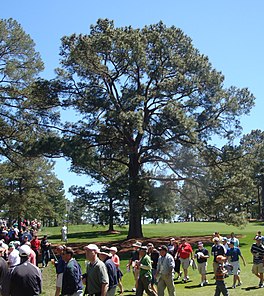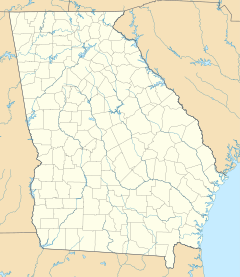The Eisenhower Tree was a loblolly pine located on the Augusta National Golf Club in Augusta, Georgia.[1] In the 1950s it was named after U.S. President Dwight D. Eisenhower who unsuccessfully lobbied to have it taken down after it interfered with his golf game. Due to its size, history, and location on a prominent golf course, it is considered iconic of the Augusta golf course[2] and is one of the most famous trees in American golf.[3] It was called "among the most famous landmarks in golf" by Cindy Boren in The Washington Post[4] and "arguably the most famous tree in golf" by Martin Dempster of The Scotsman.[5] In February 2014, the tree was removed after suffering extensive damage from a major ice storm.
| Eisenhower Tree | |
|---|---|
 The Eisenhower Tree in 2011 | |
| Species | Loblolly pine (Pinus taeda) |
| Location | Augusta, Georgia |
| Coordinates | 33°29′57″N 82°01′26″W / 33.4993°N 82.0239°W |
| Date seeded | c. 1889 |
| Date felled | February 2014 |
| Custodian | Augusta National Golf Club |
Description and origins
editThe tree species was a native loblolly pine. It stood about 65 feet (20 m) tall and was wider than is typical. It was located on the 17th hole at the Augusta National Golf Club, approximately 210 yards (190 m) from the Masters tee on the left side of the fairway. It was estimated to be 100 to 125 years old at the time it died.[1][2]
Eisenhower was an Augusta National member who spent considerable time at the club. Indeed, in November 1952 when President-elect Eisenhower needed to be briefed by an atomic energy official on highly classified nuclear matters, including that the first successful hydrogen bomb test had been held, a secret meeting was held in the manager's office within the clubhouse at Augusta National.[6]
But as much as he liked Augusta National, Eisenhower hit the tree on the 17th fairway while playing golf so many times that, at a 1956 club meeting, he proposed that it be cut down.[7][8][9] Not wanting to offend the president, the club's chairman, Clifford Roberts, immediately adjourned the meeting rather than reject the request.[8] The tree was linked to Eisenhower ever since; when Eisenhower ran for President, there were bumper-stickers that read "Ben Hogan For President. If We're Going To Have A Golfer--Let's Have A Good One!"[10]
Golfing history
editThe Eisenhower Tree has played a prominent role in the annual Masters Tournament.[2][11] One year, the Tree came into play as Tommy Aaron hit a shot off the 17th tee which became known as the "Lost Ball Incident". The ball could not be located and a drop was given. The next day according to Aaron, while playing on the 17th again, the ball apparently fell from its perch within the tree. Jack Nicklaus stated "I'm not sure I believe it."[11]
When the course was redesigned in 1999 to be more challenging, there were concerns about the tree blocking players but it proved not to be a hindrance.[12]
In 2011, Tiger Woods was playing a shot from underneath the Eisenhower and damaged his left knee and Achilles tendon when he slipped on some pine straw. The injuries sidelined him until August 2011 and his world ranking dropped to 58th.[11]
Damage and replacement
editIn February 2014, the Eisenhower Tree was removed after suffering extensive damage during a major ice storm.[11] "The loss of the Eisenhower Tree is difficult news to accept", Augusta National chairman Billy Payne said. "We obtained opinions from the best arborists available and … were advised that no recovery was possible."[13][14] The storm occurred two months before the Masters Tournament. A remnant of the tree was donated to the Eisenhower Presidential Library in Abilene, Kansas and is on display.
The loss of the tree brought tributes. Jack Nicklaus said, "The Eisenhower Tree is such an iconic fixture and symbol of tradition at Augusta National. It was such an integral part of the game and one that will be sorely missed."[15]
There is another tree named after Eisenhower, located at Dalmeny Golf Club in Scotland, planted by the President during a visit to Edinburgh to receive the freedom of the city in 1946. On hearing of the death in Augusta, the club offered to provide an acorn to plant a new oak tree.[5]
A few yards beyond the Eisenhower Tree, another tree was planted a number of years ago.[2] This tree was also removed due to the ice storm.[2]
See also
editReferences
edit- ^ a b Anderson, Dave (April 8, 1999). "Sports of The Times; Ike's Tree Re-enlists as Augusta Hazard". The New York Times. Retrieved February 18, 2014.
- ^ a b c d e Harig, Bob (February 17, 2014). "Augusta removes Eisenhower Tree". ESPN. Retrieved February 17, 2014.
- ^ Ferguson, Doug (February 17, 2014). "Augusta Ice Storm Puts an End to Eisenhower Tree". Associated Press. Archived from the original on January 14, 2015. Retrieved January 13, 2015.
- ^ Boren, Cindy (February 17, 2014). "Augusta National's Eisenhower Tree is storm casualty". The Washington Post. Retrieved February 18, 2014.
- ^ a b Dempster, Martin (February 18, 2014). "Dalmeny's acorns can grow a new Eisenhower's Tree". The Scotsman. Retrieved February 21, 2014.
- ^ Hewlett, Richard G.; Holl, Jack M. (1989). Atoms for Peace and War, 1953–1961: Eisenhower and the Atomic Energy Commission (PDF). A History of the United States Atomic Energy Commission. Vol. 3. Berkeley, California: University of California Press. pp. 1–2.
- ^ "Eisenhower Tree: Where is it, and how did it get its name?". Golf.About.com. Archived from the original on April 6, 2012. Retrieved February 17, 2014.
- ^ a b Owen, David (1999). The Making of the Masters: Clifford Roberts, Augusta National, and Golf's Most Prestigious Tournament. Simon & Schuster. ISBN 978-0684867519.
- ^ Pennington, Bill (August 20, 2012). "The Day Augusta Said Ike Was Out of Order". The New York Times. Retrieved February 17, 2014.
- ^ Lederer, Richard (January–February 2008). "Presidents at Play". Saturday Evening Post. Archived from the original on June 11, 2014. Retrieved February 18, 2014.
- ^ a b c d Boyette, John (February 16, 2014). "Masters landmark Ike's Tree suffers major damage, removed". The Augusta Chronicle. Retrieved February 17, 2014.
- ^ Kaspriske, Ron (April 8, 1999). "Eisenhower Tree no problem". USA Today. (Database: NewsBank, Retrieved February 18, 2014 )
- ^ DiMeglio, Steve (February 17, 2014). "Eisenhower Tree removed". USA Today. Retrieved February 18, 2014.
- ^ Murray, Ewan (February 17, 2014). "'Eisenhower's Tree' is a high-profile victim of severe Augusta weather". The Guardian. UK. Retrieved February 18, 2014.
- ^ "Famed 'Eisenhower Tree' at Augusta National Golf Course Felled By Ice From Winter Storm Pax". The Weather Channel. February 17, 2014. Archived from the original on February 18, 2014. Retrieved February 18, 2014.
Further reading
edit- Posnanski, Joe (February 17, 2014). "In Memoriam: Eisenhower's Tree". The Golf Channel. Accessed March 2014.
External links
edit- "Picture of fallen tree". Archived from the original on March 7, 2014. Retrieved February 19, 2014.
{{cite web}}: CS1 maint: bot: original URL status unknown (link)
